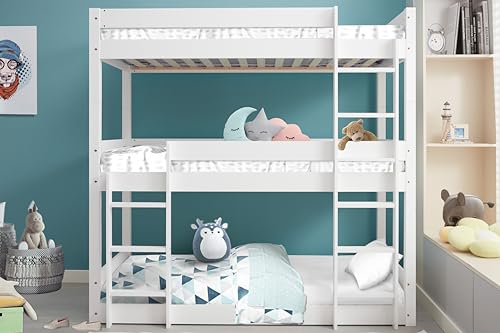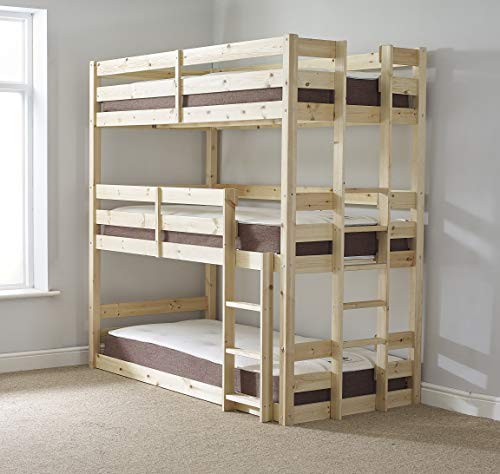pine triple bunk bed Bunk Bed
If space is tight triple bunk beds are a great solution to accommodate several sleepers in a streamlined manner. The best bunk beds are built to last and can support three people’s weight without compromising stability or safety.
Maintaining your bunk bed with regular inspections can help identify problems early and extend its lifespan. Proper care and cleaning helps keep away water damage, insect infestation and other issues that could affect the structural integrity of your bed.
Benefits
Triple bunk beds are an amazing solution for optimising space in a children’s bedroom. Three beds stacked vertically save floor space and create an open, clutter-free environment. The stacked design also encourages tidiness because personal belongings can be easily stored in the designated spaces with each bed, promoting a sense of responsibility and ownership of the space that is yours.
Another benefit of a 3 bunk bed is that it will provide more sleeping accommodations than other beds which makes it an ideal option for households with several children or for families who often host guests. You can find triple bunk beds with separate twin beds or beds that are full-sized on the lower level. Some models even come with a trundle pull-out bed, which can be used as an additional bed for guests.
These beds are also great for bonding and sibling relations as they offer siblings to be able to stay in their own rooms. The close proximity of the beds will also encourage them to spend time together, whether it is reading, playing games or sharing secrets. This sharing attitude also extends into other areas of their life, positively impacting their relationship as adults.
In addition to saving space, a triple bunk bed is an ideal option to enhance the appearance of your home. Many models feature an attractive wood finish that complements the surrounding decor. Some models even have an integrated ladder that enhances the overall look of the bedroom. Some designs have under-bed storage that can be used to store toys, books or bedding.
Regardless of the style you choose, it’s important to think about safety when buying a bunk bed. To ensure stability, make sure the model you pick is able to meet the weight requirements and is constructed of sturdy materials. Make sure that the bunks have guardrails both on the sides and front to prevent children from falling. It is also important to ensure that the ladder is easy to climb and sturdy, so that your children can climb it safely.
Design
Triple bunk beds are a great solution for spaces that are small. They are available in a range of sizes, from twin XL up to queen, to accommodate growing children or guests. They can also be customised with extra features such as desks, shelves or drawers for under-bed storage to maximize their versatility. This makes them ideal for a range of decor styles, ranging from contemporary to traditional, and fits well in rooms of various dimensions.
The most common configuration of a three-bunk bed is one that is full-sized on top and two twins below. This configuration maximizes the floor space to play and storage while providing ample sleeping space for three people. A stacked twin-over-twin arrangement is also a great choice for siblings sharing in a bedroom. If you’re looking for an even more space-saving option, think about a corner triple bunk bed that allows you to make use of the space within the room, while allowing easy access to both the upper and lower bunks that have ladders or a staircase.
Another popular option is a free-standing triple bunk bed with a ladder to reach the top bunk and an access staircase to the bottom bunk. This type of bunk bed is ideal for kids’ rooms with high ceilings, offering plenty of headspace while still accommodating nightstands, dressers and so on. This type of bunk bed can be customised with a slide to make it more enjoyment.
When building a stacked bunk bed it is crucial to choose an extremely durable and sturdy structure that will hold up to the demands of daily use. A lot of manufacturers employ a mix of metals, woods, and plastics in their designs, and some even provide an assurance of long-lasting durability. Metal brackets are used to attach beds to the wall. This helps prevent stretching, and ensures that the bed is stable and safe.
When building the frame of a triple bunk bed, it is important to take measurements and mark each leg of the bunk to ensure it is positioned on the mattress properly. If you are building a stacked bed with the middle bed being different height from the bottom bunk, be sure to cut each 2×2 at the length that allows it to fit around the lower bunk’s leg. You may also want to cut a 2.5″ square from each corner of the plywood to make it easier to fit around the legs.
Materials
A triple bunk bed is a fantastic option for sharing a children’s bedroom. It saves floor space and eliminates the requirement for additional furniture, which makes it perfect for families with smaller spaces. This kind of bed is made from robust and durable materials that can be used to accommodate up to three children without any compromise in security or comfort.
A DIY triple Bunk Beds Store bed can be made to fit your style and space. You can add visual interest using a variety of paint colors and wood finishes. Lighting can also enhance the ambience of the room. For instance, you can install LED strip lights beneath the beds or put fairy lights on the headboards to create a whimsical appearance. Be sure to install the lighting in a secure area and keep it out of reach of your children.
To construct a triple bunk bed, first cut the 2×6 boards to the required lengths. You will need a table saw for this job. After you have cut the boards, sand them to a smooth finish. Then, assemble the frames with wood screws.
You’ll need two long sides and a short side to create the bottom bunk. For the long side, you can use an 71-inch piece, and for the short side, choose 39-inch pieces. The length of the 4×4 leg which will go through these frames will be the difference in size.
Once the frame is put together, connect the slats using pocket hole screws. Be sure to drill the screws into the ends of the slats so that they aren’t visible from the bed’s front. Do not forget to glue the slats prior to installing them.
The final step is to put in the ladders. For this, you will need 1×2 trims. Attach them to the ladder rails using pocket holes, then fix them to the supports of the ladder with brad nails. Make sure you take measurements of the distance between the bottom end of each ladder and the edge of the bunk at the bottom to ensure it’s exactly the same as the measurement of the top railing.
Safety
If they are properly constructed and maintained Bunk beds that are well-constructed and maintained can be very safe. The risk of a collapse can be mitigated by selecting the right design that is in line with the safety standards of the nation, using strong durable materials and ensuring that all fittings are secure prior to use. Bunk bed safety can be improved by adhering to safety guidelines, teaching children how to use the ladder in a safe manner and ensuring that the space around the bunk bed is free from hazards such as toys, books and clothing.
It is essential to choose a bunk bed that uses mattresses instead of box springs, as these are more secure and support the weight of each sleeping person without stressing the frame. Also, it is a good idea to check the foundations of your mattress regularly for signs of wear and tear. If there is a need for a box spring for a bunk bed it is a good idea to use a low-profile foundation that sits beneath the bunk rails. This will reduce the risk of head injuries and roll-off accidents.
Make sure that the guardrails on the opposite side of the upper bunk are sufficiently long to avoid the entrapment. If the gap between the guardrail and the top of your mattress is too large it could put you at risk of strangulation. On the side of the guardrail that is closest to the wall, the gap should be small enough so that the head of a child cannot pass through them.
Children should only use the ladder or stairs to climb up into their bunk bed and not jump onto or climb onto other furniture. Ladders should be placed away from electrical outlets, light fittings and windows as well as ceiling fans to avoid tripping or falling. It is a good idea to encourage children to sleep on the lower bunk when they are less than six years old. This will also discourage rough play around or on the bunks.
 Only one person at a time to sleep on the top bunk. If the top bunk for playing is used, it may cause serious injuries when someone falls and hits their head.
Only one person at a time to sleep on the top bunk. If the top bunk for playing is used, it may cause serious injuries when someone falls and hits their head.
